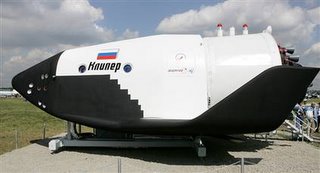
It's odd-looking, I know. This is a mock-up of the proposed Russian Space mini-shuttle 'Klipper'. It's more modern and filled with the experience of Soyuz capsule returns. The European Space Agency has agreed to support this project, but it being a shuttle and all, you sort of wonder if this is a wise investment.
Russia hopes its reusable Clipper shuttle will be ready for test flights early next decade and would then gradually take over from the veteran Soyuz spaceship, which has been putting cosmonauts in orbit since the 1960s.
Earlier this week, ministers from European Space Agency (ESA) countries failed to pledge money to the Clipper program, despite agreeing to spend more on other space research. But ESA Director General Jean-Jacques Dordain remains optimistic.
"I am convinced we can get wide support," he told reporters in Moscow after talks with Russia's Roskosmos space agency.
Officials have said Russia can theoretically fund the Clipper -- or Kliper -- program by itself but would welcome international involvement to speed up the work.
"It is not a question of member states for and member states against. I think the decision could not be taken for reasons that are not linked to Clipper itself. The decision could not be taken because of budgetary restraints," Dordain added.
Then again, you'd think that somebody somewhere might have a better way of building any kind of ERV.
Hayabusa Misses Catch

It turns out that Hayabusa didn't manage to get a sample from the asteroid.
After that, we found that there was a high possibility that the projectile (bullet) for sampling had not been discharged on Nov. 26, as we finally acquired a record of the pyrotechnics control device for projectile discharging from which we were not able to confirm data showing a successful discharge. However, it may be because of the impact of the system power reset; therefore, we are now analyzing the details including the confirmation of the sequence before and after the landing on Nov. 26.Kind of a bummer really, as that's the reasson why it was sent in the first place.
As of Dec. 6, the distance between the Hayabusa and the Itokawa is about 550 kilometers, and that from the earth is about 290 million kilometers. The explorer is relatively moving from the Itokawa toward the earth at about 5 kilometers per hour.
We are now engaging in turning on, testing, and verifying onboard equipment of the Hayabusa one by one to start the ion engine. We currently plan to shift the attitude control to one using the Z-axis reaction wheel, and restart the ion engine. The restart is expected to happen no earlier than the 14th. We are currently rescheduling the plan for the return trip to earth. We need to study how to relax the engine operation efficiency. We will do our utmost to solve the problem with the attitude control (such as the restoration of the chemical engine), then find a solution for the return trip.
Magnetic Pole Instability

The North Pole is moving South.
After some 400 years of relative stability, Earth's North Magnetic Pole has moved nearly 1,100 kilometers out into the Arctic Ocean during the last century and at its present rate could move from northern Canada to Siberia within the next half-century.This is kind of scary as it means the Van Alllen Belt will be affected.
But the surprisingly rapid movement of the magnetic pole doesn't necessarily mean that our planet is going through a large-scale change that would result in the reversal of the Earth's magnetic field, Oregon State University paleomagnetist Joseph Stoner reported today at the annual meeting of the American Geophysical Union in San Francisco, Calif.
Stoner and his colleagues have examined the sediment record from several Arctic lakes. These sediments - magnetic particles called magnetite - record the Earth's magnetic field at the time they were deposited. Using carbon dating and other technologies - including layer counting - the scientists can determine approximately when the sediments were deposited and track changes in the magnetic field.
The Earth last went through a magnetic reversal some 780,000 years ago. These episodic reversals, in which south becomes north and vice versa, take thousands of years and are the result of complex changes in the Earth's outer core. Liquid iron within the core generates the magnetic field that blankets the planet.
Shifts in the North Magnetic Pole are of interest beyond the scientific community. Radiation influx is associated with the magnetic field, and charged particles streaming down through the atmosphere can affect airplane flights and telecommunications.Nice to know, huh?
Killer Whales Are Poisonous

Being a Top Predator in the ocean means you get to absorb all sorts of toxins from your prey.
Previous research awarded this dubious honour to the polar bear, but a new study shows that killer whales have even higher levels of PCBs, pesticides and a brominated flame retardant.That's not good news either.
The results are based on blubber samples taken from killer whales in Tysfjord, a fjord in arctic Norway. This is the first time the findings of the research, carried out by the Norwegian Polar Institute (NPI), and partly funded by the Norwegian Research Council, have been revealed.
“Killer whales can be regarded as indicators of the health of our marine environment," said Dr Hans Wolkers, a researcher with NPI.

No comments:
Post a Comment